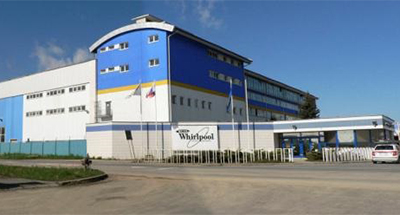With the proliferation of smaller and more frequent deliveries and the rise e-commerce, I'm normally talking to supply chain executives about how to optimize the fulfillment and delivery of items that fit in a box – a small box.
But what are the challenges facing supply chain executives at manufacturing firms that still have to grapple with shipping products the size of a washing machine or refrigerator – or, hey, what if they're actually moving washers and refrigerators?
 I had a chance to explore those challenges last week with Alison Jones, the senior director of customer fulfillment for Whirlpool Corporation's U.S. supply chain. Her organization's duties include everything from the intake of the order to delivery to the end customer. Jones, who recently celebrated her second anniversary at Whirlpool, began her career in the automotive industry, with stints and General Motors and Delphi before going to Whirlpool. “I had learned a lot working for a major automaker and Tier 1 supplier that I wanted to take to another industry,” Jones told me.
I had a chance to explore those challenges last week with Alison Jones, the senior director of customer fulfillment for Whirlpool Corporation's U.S. supply chain. Her organization's duties include everything from the intake of the order to delivery to the end customer. Jones, who recently celebrated her second anniversary at Whirlpool, began her career in the automotive industry, with stints and General Motors and Delphi before going to Whirlpool. “I had learned a lot working for a major automaker and Tier 1 supplier that I wanted to take to another industry,” Jones told me.
For example, she noted that, like automotive, Whirlpool has a very complex supply chain that includes the movement of product all over the globe, but the appliance maker was just starting to implement procedures and best practices that are more common in automotive, such as World Class Manufacturing (think lean) and Sales and Operations Planning (S&OP). “When I joined the company, there was already a push on S&OP and a project to establish processes that would support that,” Jones says. “There were gaps and opportunities.” And, she adds, there was a lot of energy and passion in the logistics team that seemed like a good fit.
Here are some of the supply chain initiatives and priorities that Whirlpool and Jones are contending with:
Optimizing Whirlpool's supply chain: Sure, Whirlpool is a 106-year-old company with a giant footprint, but the business, and the systems that support it, continue to evolve. “One of the big thing we have going on now is an investment in upgrading our systems,” Jones says. One way to think of this is that the supply chain is evolving to support the business model.
One of those system upgrades is the replacement of an aging WMS that had not been upgraded since 2007 and a second home-grown WMS with SAP's EWM. “With our old system, we weren't able to optimize or do things relative to task interleaving, cross-docking and voice pick,” Jones says.
A new WMS will also give the appliance giant the flexibility to respond to demand with new processes like drop shipping. “We need to anticipate what's happening in e-commerce and how it might impact our traditional business model,” says Jones. “In the future, we're anticipating situations like optimizing to do more home deliveries.”
New technologies on the horizon: Like other warehousers and distributors, Whirlpool is anticipating a continued labor shortage inside the four walls of the DC. That's true even though the company, like many manufacturers, works with third party logistics providers for much of its distribution. “One of our future constraints is going to be warehouse labor,” Jones says. “Even though the 3PLs are responsible for providing labor, we see that costs are going up and availability is an issue.”
Among the technologies Whirlpool is evaluating are voice, AGVs and AS/RS for the DC. “We use AGVs in manufacturing and now we're evaluating their use for long, non-valued-added runs in the DC,” Jones says. “And we're looking at what is the return on automated storage in the DC.”
The challenges on the horizon: As with any supplier into the retail space, e-commerce is threatening to disrupt Whirlpool's model and supply chain design. “We need to be positioned to have velocity, speed and precision to meet omni-channel opportunities,” Jones says. That's going to translate into a need for better forecast accuracy to position products to meet shortened lead times for delivery. And then, there's reverse logistics. “In e-commerce, people expect easy returns,” Jones says. “Returning a refrigerator is different from returning sneakers, so we're looking at that that might take.”
Bigger picture, Whirlpool is looking at how it might rejigger its traditional distribution model to meet new customer demands. That, in turn, is leading Whirlpool to investigate things like shared warehouse space in order to get closer to customers without building more million square feet distribution centers. “We need to get close to the majority of folks in the United States, but we can't just keep growing our footprint,” Jones says.
Looking forward, Jones says the message she wants to convey is that while Whirlpool might be 106 years old, it is still looking at how to improve. “We want to make sure that we stay state of the art and benchmark against the best of the best from a supply chain standpoint and not just those in our industry.”
SC
MR


Latest Supply Chain News
- How CPG brands can deliver on supplier diversity promises
- How S&OP provides the answer to in-demand products
- AI, virtual reality is bringing experiential learning into the modern age
- Humanoid robots’ place in an intralogistics smart robot strategy
- Tips for CIOs to overcome technology talent acquisition troubles
- More News
Latest Podcast

 Explore
Explore
Business Management News
- How CPG brands can deliver on supplier diversity promises
- How S&OP provides the answer to in-demand products
- AI, virtual reality is bringing experiential learning into the modern age
- Tips for CIOs to overcome technology talent acquisition troubles
- There is still work to do to achieve supply chain stability
- Blooming success: The vital role of S&OE in nurturing global supply chains
- More Business Management
Latest Business Management Resources

Subscribe

Supply Chain Management Review delivers the best industry content.

Editors’ Picks




